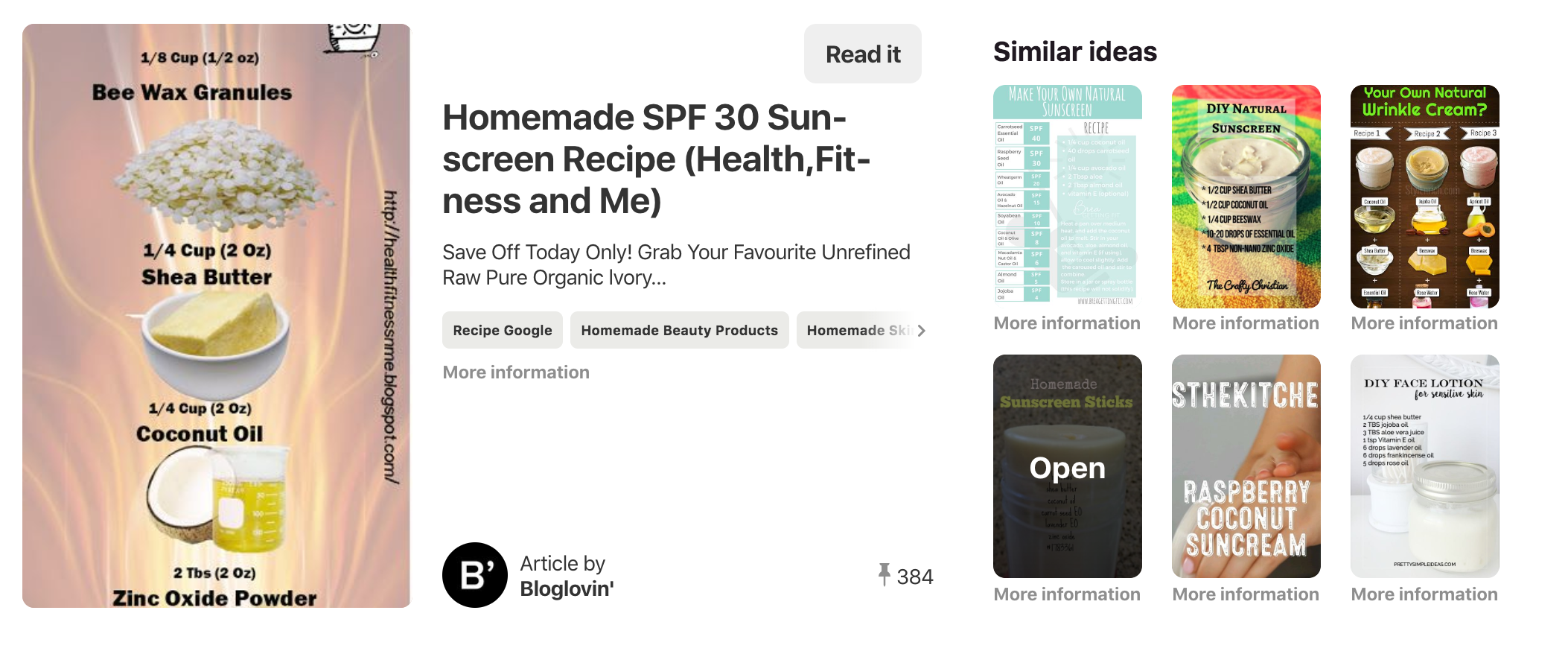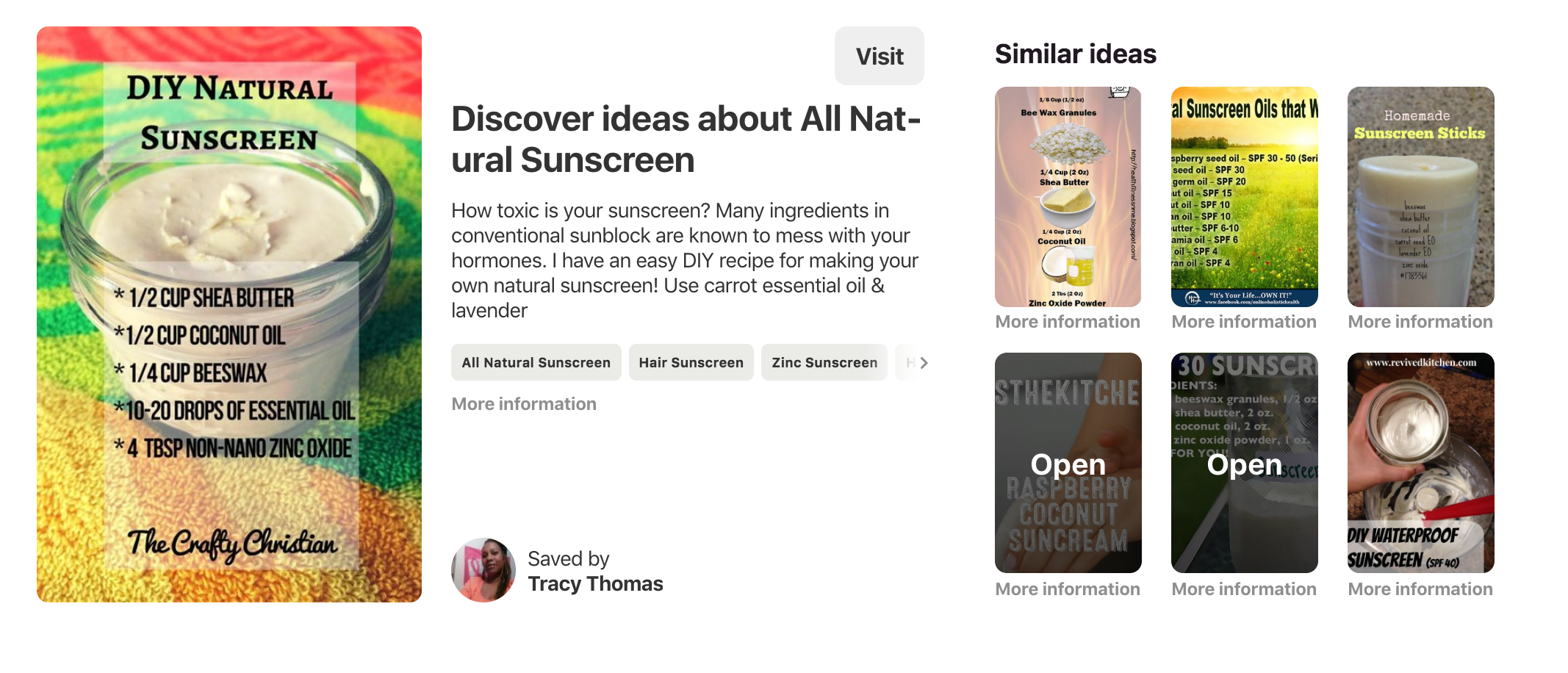Pinterest has reportedly become a breeding ground for homemade sunscreen recipes, and in related news, humanity continues to spiral incoherently toward self-annihilation. As new research investigating this haphazard phenomenon explains, “Recent consumer interest in natural products has led to an increase of shared recipes for homemade products including sunscreen. Homemade sunscreen products are risky because they are not regulated or tested for efficacy like commercial sunscreens.”
This is true: The same study found that 68 percent of the recipes they found on Pinterest “offered insufficient UV radiation protection.” To that end, some recipes resulted in formulas with a sun protection factor (SPF) of only two, whereas dermatologists recommend using a sunscreen with an SPF of at least 30.
Confused as to how the hell someone might even begin making homemade sunscreen, I created my own Pinterest and poked around. I almost immediately found these two recipes, which are basic mixtures of zinc oxide powder, coconut oil and beeswax, among several other natural things, like shea butter and essential oils:


Now, zinc oxide is a common ingredient in commercial sunscreens, since it helps to physically reflect dangerous ultraviolet rays. The other ingredients, however, provide virtually zero sun protection. Sure, zinc oxide has the potential to protect your skin, but the big problem with homemade recipes is that producing adequate sunscreens requires careful and meticulous formulating, which is almost certainly impossible to accomplish in your bathroom sink.
“These at-home recipes probably won’t give you the formulation needed to create that sun protection,” dermatologist Anthony Rossi confirms, adding that you can easily end up with an immeasurable and ineffective SPF. He also mentions that these homemade sunscreens might only protect against one type of radiation, whereas broad-spectrum commercial sunscreens protect against both UVA radiation (the kind that causes premature skin aging and wrinkling) and UVB radiation (the kind that causes sunburns and melanoma skin cancer). Simply put, Rossi says, “If you’re haphazardly making it and using it, you’re probably not getting as protected as you want to be.”
But since the people making homemade sunscreen are presumably doing so because they’ve been hearing a lot about how chemicals in the commercial stuff are dangerous, I feel obliged to address that. Basically, chemical sunscreens — which are different than mineral sunscreens containing zinc oxide in that they attenuate the UV radiation, rather than simply blocking it — often contain ingredients like avobenzone, octinoxate and oxybenzone. These are believed to be harmful to coral reefs and possibly even the human endocrine system, which produces hormones that help with all kinds of bodily functions, when absorbed into the skin.
Rossi mentions that at least some of the fear surrounding these chemical sunscreens stems from a recent FDA warning, which points to some studies showing that these potentially harmful ingredients can indeed be absorbed into the body. However, the FDA never claimed that these sunscreens should be avoided as a result. In fact, they said the exact opposite:
“The fact that an ingredient is absorbed through the skin and into the body does not mean the ingredient is unsafe. Rather, this finding calls for further testing to determine the safety of that ingredient for repeated use.
“While industry and other interested parties develop further data, the public should continue to use sunscreens with other sun protective measures. Broad spectrum sunscreens with SPF values of at least 15 remain a critical element of a skin-cancer prevention strategy that includes other sun protective behaviors such as wearing protective clothing that adequately covers the arms, torso, and legs; wearing sunglasses and a hat that shades the whole head; and seeking shade whenever possible during periods of peak sunlight.”
So, yeah, evidence suggests that chemical sunscreens could possibly have the capacity to mess with our bodies. But as far as we currently know, skin cancer is still a far more worrisome problem. If you’re really that concerned about the potential dangers that come with chemical sunscreens, instead of making your own crappy sunscreen and burning the hell out of yourself, just use a sunscreen that doesn’t contain those possibly harmful ingredients.
It really is that easy, folks — no skin cancer required.

